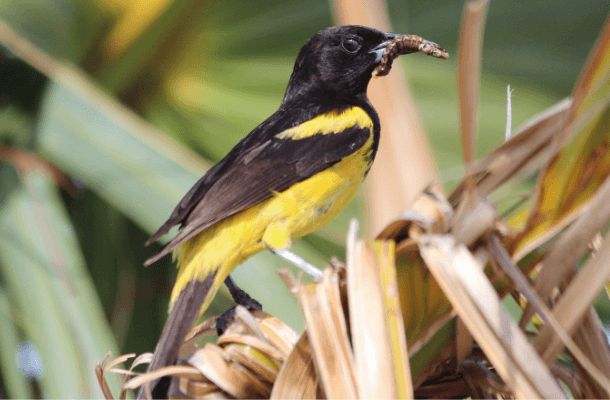Changing Fortunes for Two Bahamian Endemics

The Bahama Oriole is found only on Andros. Photo by Daniel Stonko
The past few months have brought a dramatic shift in the conservation outlook for two bird species endemic to the Bahamas, one — the Bahama Oriole — thanks to improved knowledge and the other — the Bahama Warbler — due to catastrophic natural events.
For several years, researchers from the University of Maryland, Baltimore County (UMBC) in partnership with the Bahamas National Trust (BNT) have been studying the Critically Endangered Bahama Oriole, which is found only on Andros Island. For years, it was assumed that these striking yellow-and-black songbirds were restricted to the east coast of Andros, where they favored nesting in coconut palms in and around human settlements.
Numbering fewer than 300 individuals, it seemed the species was threatened by the loss of palm nesting sites due to lethal palm-yellowing disease combined with brood parasitism by Shiny Cowbirds. Such a tiny population would rank the species among the most imperiled in the Western Hemisphere.
However, studies conducted from 2016 to 2018, supported in part by American Bird Conservancy, changed this narrative, starting with UMBC alumnus Daniel Stonko's documentation of the first Bahama Oriole nests in pine forest. This work was followed by that of another UMBC alumna, Briana Yancy, who showed that nesting in pine habitat was not unusual for Bahama Orioles; in fact, the birds often prefer it.
Andros, at 2,300 square miles, is by far the largest of the Bahamas' 700 major islands. With more than 20 percent of the island covered in pine forest, the status of the Bahama Oriole was in critical need of re-evaluation. That brings us to the present and the publication of a new study by UMBC alumnus Michael Rowley and co-authors from UMBC, BNT, the University of Florida, and the Smithsonian Conservation Biology Institute. Rowley and the team conducted surveys over roughly 25 percent of Andros and concluded that the oriole population is likely between 1,300 and 2,800 birds — perhaps as much as 10 times the previous estimate. Rowley says the new information is “a step forward for conservation,” noting: “This makes the world a bit more informed about what we should be putting our efforts toward.”
Kevin Omland, the faculty mentor and research leader at UMBC, will work with BirdLife International, which is the International Union for Conservation of Nature (IUCN) Red List authority for birds, to review the oriole's population status. The species will likely be downlisted from Critically Endangered to a lower threat category. Dr. Omland and his students are now turning their attention to learning where the orioles go after nesting. To best direct conservation efforts, that information will be key to understanding how important other habitats might be to the species during other parts of its annual cycle.
Elsewhere in the Bahamas, in the first days of September 2019, Hurricane Dorian, a Category 5 storm, hit northern Abaco and Grand Bahama. The human toll on both islands was tragic, and those communities are still struggling to recover. During January and February 2020, expeditions led by BNT and ABC with key support from the National Geographic Society and BirdsCaribbean surveyed the status of resident and migratory birds on the two islands and quantified the damage to their forests.

The Bahama Warbler is restricted to the Bahamian islands of Abaco and Grand Bahama. Photo by Daniel Lebbin
While northern Abaco was devastated, extensive pine forests in southern Abaco, including Abaco National Park, were spared and contained robust populations of pine-dependent birds, in particular the endemic Bahama Warbler, which is known only from Abaco and Grand Bahama. By contrast, the pine forests on Grand Bahama were almost completely destroyed. Only one endemic bird species was detected during the surveys, a lone Bahama Yellowthroat, and, critically, no Bahama Warblers. The Bahama Nuthatch, which is known only from Grand Bahama and was last seen in 2018, is now feared extinct following Dorian.
After the post-Dorian expeditions, the BNT-ABC team, along with William Hayes of Loma Linda University in California, submitted their new information about the Bahama Warbler to BirdLife International. The team recommended that the Bahama Warbler be uplisted from Near-Threatened to Endangered since it is now effectively a single-island endemic with at least 95 percent of its population confined to Abaco, where there may be fewer than 1,700 birds. BirdLife concurred and BNT is ramping up its efforts to better understand the warbler's habitat and food requirements on Abaco and the long-term prospects for habitat restoration on Grand Bahama.
The tale of these two Bahamian endemic species highlights conservation issues specific to the Bahamas, but also others shared with other West Indian islands. The Bahama Oriole and Bahama Warbler, and indeed the now-possibly extinct nuthatch, are examples of the spectacular array of highly localized bird species that have evolved in isolation on Caribbean islands, with many restricted to single islands.
These range-restricted island species are inherently more vulnerable to extinction because literally all of their eggs are in one basket — threats such as hurricanes or invasive, nonnative species can quickly impact their entire range. In the Bahamas, the islands of Andros, Abaco, and Grand Bahama hold the lion's share of the archipelago's pine forest, also supporting other pine-dependent species, among them the Endangered Bahama Swallow and the Bahamian subspecies of the Cuban Parrot.
Effective protection and management of Bahamian pine forests will be vital to maintaining strong populations of these species. On northern Abaco and Grand Bahama, forest restoration will be key to recovering Bahama Warbler populations and hence enhancing this species' long-term security. Our changing climate and the increase in the number and severity of hurricanes lend urgency to these efforts.
ABC gratefully acknowledges the support of the National Geographic Society for its support of the post-Hurricane Dorian surveys.
###
Media Contact: Jordan Rutter, Director of Public Relations, 202-888-7472 | jerutter@abcbirds.org | @JERutter
Expert Contact: George Wallace, Director of International Programs and Partnerships | gwallace@abcbirds.org
American Bird Conservancy is a nonprofit organization dedicated to conserving wild birds and their habitats throughout the Americas. With an emphasis on achieving results and working in partnership, we take on the greatest problems facing birds today, innovating and building on rapid advancements in science to halt extinctions, protect habitats, eliminate threats, and build capacity for bird conservation. Find us on abcbirds.org, Facebook, Instagram, and Twitter (@ABCbirds).


















































